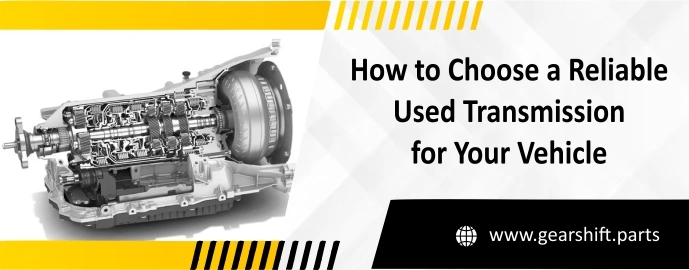
How to Choose a Reliable Used Transmission for Your Vehicle
A transmission failure is never cheap. If you’ve dealt with it, you already know how expensive it can get. A brand-new transmission can cost more than the car is worth. That’s the reason most people look at a used transmission instead. It’s the practical way out. But buying one isn’t as easy as grabbing the first unit you see online or at a salvage yard. If you pick wrong, you’ll waste money and time, and the car may end up back in the shop. Here in this guide, we will points out what you really need to check before you buy used transmission.
Why Buying a Used Transmission Makes Sense
- The first and biggest reason is money: A new or remanufactured transmission can cost thousands of dollars. A used one is often half the price or less. For many owners, it’s the only realistic option.
- The second reason is availability: If you own an older car, you may not even have the choice of buying new. Automakers stop producing certain parts after a while, and transmissions are no exception. A used option might be the only option.
- The third reason is convenience: Salvage yards, shops, and online parts sellers keep these parts ready to go. That means you don’t wait weeks for a factory order.
What You Must Check Before Buying
Not all transmissions are equal. Some still have years of life in them, while others are close to failing. Here’s what you need to focus on:
- Compatibility: This is the most important step. Transmissions vary even within the same model year. Use your VIN or the transmission code to confirm. Guessing here will cost you more than you save.
- Mileage: Fewer miles on the transmission are better. Less than 75K miles is a solid benchmark. 100K+ miles means you’re gambling.
- Condition: Inspect the used transmission for leaks, cracks, and rust. Check the fluid if possible. Good fluid is red and clean, not dark and burnt.
- Testing: Ask if the seller has tested the transmission. Some do pressure tests or spin tests before listing them. This gives at least some confidence that the part works.
- Warranty: A warranty, even a short one, adds protection. Many sellers offer 30 to 90 days. If the seller offers nothing at all, that’s a red flag.
Where to Buy a Used Transmission
The place you buy from matters just as much as the part itself. Here are the main options:
- Local salvage yards: Cheapest prices, but often sold “as-is.” You’ll have to take the risk.
- Online suppliers: At gearshift.parts, we carry wide selections and usually provide mileage and condition details. Easy to compare models before you buy.
- Repair shops: Some shops source used transmissions for you. They handle buying and installation, though costs are slightly higher.
- Private sellers: They are the cheap option in many cases but also have the high number of risk. There is no warranty, testing, and guarantee of the part.
How to Spot a Reliable Transmission
To find a reliable unit among many, here are the things you need to look for:
- Look for clean transmission fluid.
- No visible cracks or dents on the case.
- Seals those aren’t dried or broken.
- No heavy rust or corrosion.
- Seller can confirm mileage and history.
If you’re buying online, ask for photos and written details. At gearshift.parts, we provide clear inspection information before shipping.
Price Range You Should Expect
Prices change depending on the type of vehicle:
- Small cars: $400 to $800
- Sedans and crossovers: $800 to $1.2K
- Trucks and heavy-duty vehicles: $1.2K to $1.8K
- Luxury and high-performance vehicles: $2K+
These prices are only for the part itself. Labor is another cost. On average, professional installation ranges from $500 to $1,500 depending on the vehicle. Keep that in your budget so you’re not surprised later.
Why Installation Should Be Done by a Professional
Even if you get the best transmission, it won’t last if it’s installed wrong. Transmission replacement is complicated. It’s not like swapping a battery or an alternator. Alignment, cooling lines, proper fluid levels, and torque checks all matter.
Also, many warranties require professional installation. If you try to install it yourself and something goes wrong, you lose your warranty and your money.
Practical Buying Tips
Here are the practical tips to buy used transmission:
- Always confirm the transmission code. Don’t assume.
- Don’t rush the process. Compare multiple sellers and their offers.
- Ask for mileage proof or at least written confirmation.
- Look for sellers that give a return option or short warranty.
- If you buy used transmission online then you need to ask for photos and condition reports before payment.
Always remember cheap doesn’t mean it is better. More expensive unit with low-mileage and warranty is a smart choice.
Conclusion
Choosing to buy used transmission is often the only affordable way to keep a car on the road. But you have to do it right. Check compatibility, check mileage, look at condition, and never ignore warranty terms. Take your time instead of grabbing the first cheap unit you find. A good used transmission can last for years and save you thousands. A bad transmission will put back in the mechanic shop. Always buy from trusted seller, ask question, and keep your budget for installation. In this way, you will get reliable used transmission without the stress.

